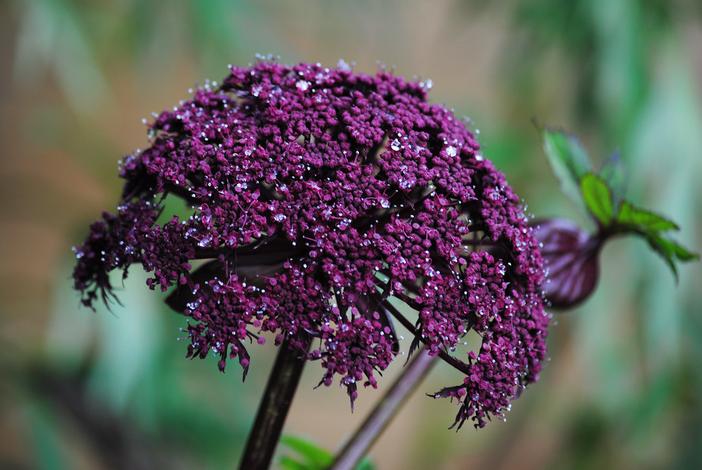Korean Angelica
(Angelica gigas)
Korean Angelica (Angelica gigas)
/
/

Mark
CC BY 2.0
Image By:
Mark
Recorded By:
Copyright:
CC BY 2.0
Copyright Notice:
Photo by: Mark | License Type: CC BY 2.0 | License URL: https://creativecommons.org/licenses/by/2.0/ | Uploader: Mark Wordy | Publisher: Flickr


























Estimated Native Range
Summary
Angelica gigas, commonly known as Korean angelica, is a biennial or short-lived perennial herb that is native to moist mountain streamsides and forest edges in Korea and China. It can grow to a height of 3 to 7 feet with striking purple stems and large, bipinnate, and coarsely toothed leaves that add a bold texture to garden settings. From late summer to early fall, Korean angelica produces large, dome-shaped umbels of tiny, deep reddish-purple flowers that are highly attractive to pollinators and add a dramatic touch to the landscape.
Korean angelica is valued for its architectural form and the unique color of its flowers and stems, making it a focal point in borders and cottage gardens. It is also used in traditional medicine, with ongoing research into its pharmacological potential. In cultivation, it thrives in moist, fertile soils with good drainage and can tolerate full sun to partial shade. While it is generally easy to maintain, it may require staking in windy sites to prevent stem breakage. This plant can self-seed prolifically under ideal conditions, which should be managed to prevent unwanted spread.CC BY-SA 4.0
Korean angelica is valued for its architectural form and the unique color of its flowers and stems, making it a focal point in borders and cottage gardens. It is also used in traditional medicine, with ongoing research into its pharmacological potential. In cultivation, it thrives in moist, fertile soils with good drainage and can tolerate full sun to partial shade. While it is generally easy to maintain, it may require staking in windy sites to prevent stem breakage. This plant can self-seed prolifically under ideal conditions, which should be managed to prevent unwanted spread.CC BY-SA 4.0
Plant Description
- Plant Type: Herb
- Height: 4-6 feet
- Width: 2-3 feet
- Growth Rate: Moderate
- Flower Color: Purple
- Flowering Season: Summer, Fall
- Leaf Retention: Deciduous
Growth Requirements
- Sun: Full Sun, Part Shade
- Water: Medium
- Drainage: Medium
Common Uses
Bee Garden, Bird Garden, Butterfly Garden
Natural Habitat
Moist mountain streamsides and forest edges in Korea and China
Other Names
Common Names: Purple Angelica, Korean Tanggwi, Chamdanggwi, Chao Xian Dang Gui, Oni-Nodake, Giant Angelica
Scientific Names: , Angelica gigas,
GBIF Accepted Name: